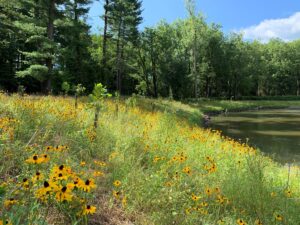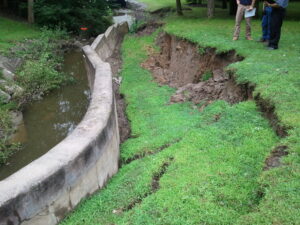My Stream
Stream Stewardship: the idea that each and every one of us is responsible for the sensible use of streams that flow through our property. From your yard to your streams, we’re all connected. Even if you don’t have a stream running through your yard, your actions on your property can have impacts on our waterways. Making the connection between your yard and its downstream impact on our natural resources is critical for maintaining and improving the water quality of our streams.
Our streams and lakes are a resource that should be protected as a source of natural beauty and recreation. In addition, the areas surrounding them are an integral part of communities’ infrastructure as they assist in managing pollutants and flooding. Read on to see what you can do to protect our streams.
Practice Stream Stewardship:
- Download our guide. Stream Stewardship Guide for Property Owners
- Protect your stream banks from erosion.
-
- Maintain a vegetated riparian zone.
 The riparian zone should be a minimum of 25 feet wide for headwater or small streams. Wider riparian zones are recommended for larger streams. Avoiding mowing and building structures within the riparian zone is essential for maintaining stream health. This distance will vary if your community implements a riparian setback regulation (see https://crwp.org/riparian-setbacks/). To determine if your community has such zoning requirements, visit https://codelibrary.amlegal.com/regions/oh or contact your community engineering, building, or zoning department.
The riparian zone should be a minimum of 25 feet wide for headwater or small streams. Wider riparian zones are recommended for larger streams. Avoiding mowing and building structures within the riparian zone is essential for maintaining stream health. This distance will vary if your community implements a riparian setback regulation (see https://crwp.org/riparian-setbacks/). To determine if your community has such zoning requirements, visit https://codelibrary.amlegal.com/regions/oh or contact your community engineering, building, or zoning department. - Plant native deep-rooted plants in the riparian zone hold soil in place. Native vegetation (flowers, shrubs, or trees found in Ohio) is the number one resource for preventing erosion.
- Keep lawn wasteaway from the edge of streams. Grass clippings or leaves piled along stream banks will kill stream bank vegetation and cause more erosion. Instead, setup your own composting bin away from the stream.
- Maintain a vegetated riparian zone.
- Stabilize eroding stream banks.
-
- Plant live stakes. A stream bank with limited damage may be stabilized with live stakes (see Plant Live Stakes to Stabilize Your Streambanks). The banks are planted with deep rooted plants that can hold soil in place and can withstand flooding and fast moving water. These plants also provide wildlife habitat and improve water quality. Learn more about native plants and where to buy them here.
- Avoid placing hard materials like railroad ties, concrete or large stones to stop stream bank erosion.
 While placing hard materials on an eroding stream bank may appear to solve the problem, these practices often fail because they do not stabilize the bank properly. If installed incorrectly, these materials can narrow the stream, causing faster flows and more erosion. Hard materials also tend to either peel away from the bank, or slump into the stream. Inappropriate solutions may cause more long-term damage than doing nothing at all. Also, in-stream work to install these hard materials requires an Ohio EPA 401 permit and a US Army Corps of Engineers permit. E-mail contact@crwp.org if you need guidance on who to contact to help you stabilize your stream banks.
While placing hard materials on an eroding stream bank may appear to solve the problem, these practices often fail because they do not stabilize the bank properly. If installed incorrectly, these materials can narrow the stream, causing faster flows and more erosion. Hard materials also tend to either peel away from the bank, or slump into the stream. Inappropriate solutions may cause more long-term damage than doing nothing at all. Also, in-stream work to install these hard materials requires an Ohio EPA 401 permit and a US Army Corps of Engineers permit. E-mail contact@crwp.org if you need guidance on who to contact to help you stabilize your stream banks. - Leave some woody debris in the stream channel. It can be moved to the banks to help stabilize them.
- Manage Stormwater Runoff (see https://crwp.org/wet-yard/)



